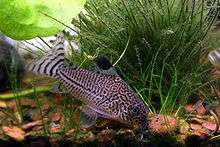Corydoras julii
Corydoras julii (also known as the julii cory or leopard catfish[1]) is a small freshwater catfish native to eastern Brazil. It is a popular aquarium fish.
| Corydoras julii | |
|---|---|
 | |
| Scientific classification | |
| Kingdom: | Animalia |
| Phylum: | Chordata |
| Class: | Actinopterygii |
| Order: | Siluriformes |
| Family: | Callichthyidae |
| Genus: | Corydoras |
| Species: | C. julii |
| Binomial name | |
| Corydoras julii Steindachner, 1906 | |

In the aquarium
Julii corys are small peaceful fish, and are therefore often kept in community aquariums with other community fish. As they are shoaling fish,[2] they are often kept in groups of more than 3 fish in aquariums. Some recommend that they be kept in at least a 20-gallon tank.
They grow to about 2-3 inches . It is recommended that you provide these fish with sinking pellets along with live and frozen fish food.
Physical appearance
Julii corys are some of the most commonly sought corys because of their beautifully patterned bodies. Their flesh is a whitish-gray, almost transparent color with fine black spotting all over. A julii cory can be distinguished from other similar 'spotted' corys by the fine spotting pattern and also their black mark on their dorsal fin; similar species have either larger spots or spots merged into short wavy lines. They grow to less than 2.5 inches long,[3] making them one of the smaller members of the cory family. They are rarely available commercially; fish labelled as "julii corys" are often misidentified C. leopardus, or three-stripe ("false julii") cory catfish (C. trilineatus)).[4]
Feeding
Julii corys are scavengers and omnivores that will eat food that sinks to the bottom of the tank. In aquaria, they are often given sinking pellets or flake food. Frozen bloodworms and brine shrimp should be given as a treat; live bloodworms are also a favorite.
Breeding
Sexing corys is not very difficult provided they are in well fed and in good condition. Females are quite a bit rounder than males. Usually cory catfish are bred in groups of two males to one female. They can also be bred in a large school.
The fish will spawn after sexual maturity, during a storm. During this storm, the fish eat increased amounts of insects. The water gradually decreases temperature over the course of a few days .
Corydoras fish spawn in an unusual position. They make a sort of "T formation" as most experts report, the female fish, enticed by the male, swims up to the male's abdomen. She will eat the sperm released by the male fish. the sperm rapidly travels though the female's body and fertilizes the eggs . The female then lays eggs into her pelvic fins. After mating, the female will place the eggs on a surface and repeat this process.
Corys are egg laying fish and will lay small, white, sticky eggs on all surfaces in the aquarium, often on the glass itself. Females lay many eggs at a time though, the catfish will eat most of the eggs unless removed.
References
- "Corydoras julii summary page". FishBase. Retrieved 2019-01-07.
- "Corydoras julii • Callichthyidae • Cat-eLog - PlanetCatfish.com". www.planetcatfish.com. Retrieved 2019-01-07.
- "Corydoras julii • Callichthyidae • Cat-eLog - PlanetCatfish.com". www.planetcatfish.com. Retrieved 2019-01-07.
- "Corydoras julii • Callichthyidae • Cat-eLog - PlanetCatfish.com". www.planetcatfish.com. Retrieved 2019-01-07.
External links
- Froese, Rainer and Pauly, Daniel, eds. (2011). "Corydoras julii" in FishBase. December 2011 version.